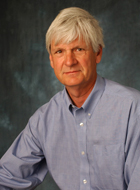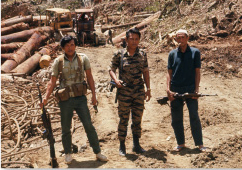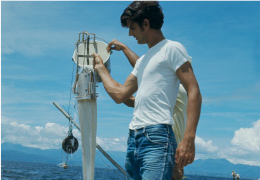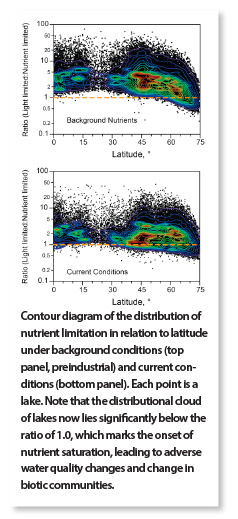A Forty-Year Lake Odyssey
CIRES Interim Director’s quest to compare and contrast lakes across the globe
 In 1970, William Lewis Jr., currently CIRES interim director, departed for the Philippines with the mission of studying Lanao, a large lake on the southern island of Mindanao. He landed in a region in the throes of conflict between the Christian Filipino government, centered in the north, on Luzon, and the locally dominant Muslim population, which was estranged from the north and in varying stages of rebellion. Although both sides were quite friendly to Americans, the unrest generated some civil chaos that led to hijacking attempts on Lewis’s research boat, which luckily proved to be faster than the wooden boats of his would-be captors. Fortunately the motor started each time it needed to, or CIRES would have a different interim director.
In 1970, William Lewis Jr., currently CIRES interim director, departed for the Philippines with the mission of studying Lanao, a large lake on the southern island of Mindanao. He landed in a region in the throes of conflict between the Christian Filipino government, centered in the north, on Luzon, and the locally dominant Muslim population, which was estranged from the north and in varying stages of rebellion. Although both sides were quite friendly to Americans, the unrest generated some civil chaos that led to hijacking attempts on Lewis’s research boat, which luckily proved to be faster than the wooden boats of his would-be captors. Fortunately the motor started each time it needed to, or CIRES would have a different interim director.
Lewis—at that time a doctoral student at Indiana University—was working solo. His advisor, Professor David Frey, had become ill and was forced to drop out of the trip. "I had the entire budget and almost no experience, but plenty of ambition," Lewis said.
Lewis’s goal was to establish a laboratory, hire some help, and use modern equipment to learn about food webs in Lake Lanao as well as its chemical and physical processes and their variations across an entire year or more. "I was motivated by the vagueness of notions that limnologists had about tropical lakes at that time," Lewis said.
Although limnologists had briefly visited many tropical lakes, tropical lakes had not been studied for an extended time across a broad range of ecosystem characteristics such as seasonality (do they show any?), productivity (higher or lower than at temperate latitudes?), and biodiversity (high, as in tropical forests?), Lewis said. Limnologists at the time hypothesized that tropical lakes would not show seasonality because tropical climates show low annual variation in temperature. Lewis’s two-year project on Lake Lanao demonstrated otherwise.
The study found seasonality at Lanao, and this result has since been confirmed for tropical lakes at other locations. "In fact tropical lakes show strong seasonality, which we did not expect," Lewis said. Seasonality in temperature and heat budgets causes ecological seasonality in lakes, he said. From the human perspective, tropical seasonality is weak or not detectable, but it is sufficient to cause alteration of water column stratification and mixing, the cause of seasonality in lakes.
Spanning the globe
Lewis launched his career in limnology with publication of his studies of Lake Lanao. During the 1970s his research took him to tropical and subtropical lakes in Florida, South Carolina, and Laos. Beginning in 1974, as a faculty member of the University of Colorado Boulder, he studied lakes in Venezuela, lakes at high elevation in Colorado, and arctic lakes on Baffin Island.
"The importance of lakes is higher than one might expect based on global lake area (approximately 2 percent of land area)," Lewis said. Lakes offer water storage and, in many parts of the world, supply protein, mostly as fish, for people who live where other sources of protein are scarce, he said.
As early as 1971, he became interested in comparing tropical lakes and lakes farther from the equator, and his research over the next three decades allowed him to explore their similarities and differences. In the new millennium, his goal became more ambitious: to map fundamental properties of lakes across latitude. "Latitude controls the differences between tropical and temperate lakes, but the underlying mechanisms have been a mystery," Lewis said.
 As a starting point, Lewis chose to focus on a key property of lakes: biomass production by photosynthesis—a measure of how much plant matter a lake produces. "We have estimates of the production of oceans and terrestrial environments," Lewis said, "but even in 2009 we did not have estimates of the total production of lakes. My study was intended as a companion piece to the information we have about other components of the global environment."
As a starting point, Lewis chose to focus on a key property of lakes: biomass production by photosynthesis—a measure of how much plant matter a lake produces. "We have estimates of the production of oceans and terrestrial environments," Lewis said, "but even in 2009 we did not have estimates of the total production of lakes. My study was intended as a companion piece to the information we have about other components of the global environment."
Using data collected over the previous four decades by many investigators, Lewis and colleagues in 2010 created a model of the global biomass production of lakes. The researchers modeled the seasonal cycle for every latitude, taking into account a range of factors that influence production, such as lake depth and area, nutrients, and water temperature.
"Controlling factors interact, and a look across latitudes shows how they interact," Lewis said. "Understanding what controls lake production was a major motivation of the latitude study." Lake productivity has direct consequences for the ability of lakes to sustain water of good quality and production of useful biomass, he said.
 Pollution-powered productivity
Pollution-powered productivity
Not all the factors controlling lake production are entirely natural. The global model constructed by Lewis demonstrated that lakes across latitudes have become more fertile and, thus, now produce more biomass than previously. The source of additional nutrients is anthropogenic pollution such as fertilizer runoff, wastewater effluent, and nitrate mobilized through the atmosphere by fossil fuel combustion.
While increased fertility might be good for soil, it is generally undesirable for lakes, at least from the human perspective, Lewis said. For example, coldwater fish—trout and salmon—suffer in more fertile lakes where certain unfavorable fish and plant species thrive.
"From nutrient pollution, we get nuisance species that are not useful, and we lose species of high value," Lewis said. Nutrient pollution is not now fully addressed in lake management, he said. New regulations are intended to protect lakes and other inland waters against nutrient pollution in the future.
The model also revealed striking differences in lake productivity at different latitudes, Lewis said. Near the equator, more sunshine and higher temperatures cause lakes to produce more biomass with a given influx of nutrients than do lakes at higher latitudes. "In the tropics, lakes must be managed very carefully because they respond strongly to increased nutrient supply," he said.
Limnologists have believed that the largest lakes account for most global lacustrine biomass production. Lewis’s model, which takes into account all lakes, demonstrates that smaller lakes make a large contribution to the global total.
Does Lewis ever worry that there are now no vague notions left to clarify? "Global environmental studies, now a frontier in ecology, open new subjects for study," Lewis said. "The global lake story has become more interesting, not less."
Fast-forward 20 years: a 60-year lake odyssey?



